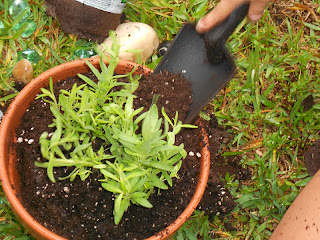Yesterday October 17, 2011 we started our butterfly garden. The children had a great time despite the rain and we had the opportunity to used some tools and played with dirt to plant some of the flowers we have had acquired for our garden. So far we got lantanas, pentas, and milkweed. We still have to plant half of the plants and let them grow to see them blossom. That will be an interesting process for our students. Already we’ve got two Monarch chrysalis/pupa on a milkweed plant and two caterpillars. We will document their development. These breeds of Monarchs are a 4th generation meaning that they will live approximately from 6-8 months (see fun facts below).
Our official photographer of the day was Isabella so enjoy her shots. She also shared other responsibilities such as helping the little ones with Geronimo. Adria, Anna Catalina, Sebastian, Ben, and Simon were our official sketchers of the garden and nature chasers along with Felipe and Hugo. Geronimo, Simon, Ethan, Augusto, and Anna Catalina took a more hands on approach with the soil (digging and planting) in other words getting dirty. We saw along the way some: snails, centipedes, unidentified bugs, lizards, and mosquitoes. We will keep you posted of our eco-friendly adventures in the garden.
Monarch Fun Facts:
Did you know that the monarch butterflies that live in North America migrate? Monarch butterflies are the only insect to migrate up to 2,500 miles to get out of the cold weather and hibernate. But not all monarch butterflies migrate; only the fourth generation of monarchs can migrate each year because the first three generations die after about six weeks from escaping their cocoons.
Did you know that monarch butterflies go through four generations each year? The first three generations hatch from their cocoon state (also known as the pupa or chrysalis state) and live for up to six weeks, but the fourth generation continues to live on for up to six or eight months so that they can migrate to a warmer climate, hibernate, and then start a new first generation in the spring time.
Female monarch butterflies have several hundred eggs to lay during their short life in the spring time. Monarch butterfly larvae eat milkweed and they need them to live. Did you know that milkweed plants are being cut down to make roads and houses and the monarch butterfly population is decreasing because of this? Conservationists are working hard to bring back the milkweeds so that monarch butterflies have a place to live and grow.














































No comments:
Post a Comment